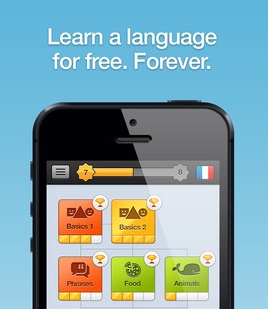
About
This page highlights a select group of games, educators, and educational research in the area of gamification. Some of the top educators related to gamification, including some listed below, were featured at this year’s GSummit 2013 (link here). The gamification of education is rapidly being incorporated into classrooms across the world and these are just a few examples.
Games:
Duolingo is a new learning tool that uses gamification to teach and reinforce language learning. Say that you’re a beginning learner and want to build your vocabulary and translation skills. Log into duolingo.com, sign up and begin learning Spanish, French, Portuguese, German or Italian. The website has a desktop version that works on both the Mac and Windows platforms. You can also go mobile and run the learning program on either iPhone or Android devices. And the best part? It’s all completely free.
Duolingo cleverly incorporates gamification by awarding points for completing vocabularyexercises and keeping track of the learner’s progress through line scales and level badges along the way. Log in each day for new sessions to view previous progress, your current level and to do optional review practice.
DragonBox was conceived with the belief and the vision that human beings are hardwired to learn extremely complicated concepts. By placing the student at the center of the learning process one can engage the brain of the students in an optimal manner, achieving results in agreement with the marvelous capacity of the human brain. Therefore, DragonBox does not teach mathematics in the “right order”. It starts byteaching algebra before arithmetic. DragonBox does a fantastic job at reducing what would normally take years to learn down to a couple of hours. DragonBox was featured here on Gamification.co.
The WoWinSchool Program uses the game, World of Warcraft, as a focal point for exploring Writing/Literacy, Mathematics, Digital Citizenship, Online Safety, and has numerous projects/lessons intended to develop 21st-Century skills. Because of the success of the first year’s implementation as an after school program, the program is now being implemented as a language arts elective for middle schoolers designed to provide enrichment for students at all levels. The program is spreading, too. To date, twelve schools in the U.S. and Canada have used our materials and have joined the adventure. The WoWinSchool Program was featured here on Gamification.co.
Educators:
Professor of English, Florida State College at Jacksonville
Jacksonville, FL
Senior Program Officer, Bill and Melinda Gates Foundation
New York, NY
CEO, Co-founder, Course Hero
As co-founder and CEO of Course Hero, a top provider of online study resources that supplement college courses and help students learn more effectively, I am passionate about students. Having recently been one myself, I’m a firm believer in the power of technology to transform education for the better. Course Hero was born from a simple yet powerful observation that students and teachers create an incredible amount of interesting and valuable knowledge in the form of lectures, notes, study guides, outlines, research, analysis, exams, assignments, syllabi, labs, and much more that they never end up sharing beyond the four walls of their classrooms. At Course Hero, we’re working to create a collaborative environment between students and teachers regardless of where and when they are learning or teaching. With gamification elements peppered throughout CourseHero.com, those who upload academic documents can share such achievements on various social media channels, encouraging friends and followers to do the same.
Teacher of Economics
Tim is a school teacher who uses MONOPOLY to teach economics, probabilities, expected values, social negotiation skills and much more in grades 4-12. His socio-economically disadvantaged sixth graders have defeated U.S. & World Champions multiple times in actual tournament play, in addition to earning perfect scores on state math tests numerous times. Tim was featured at GSummit 2012.
Third Grade Teacher
As former globetrotting business executive turned elementary school teacher, Ananth Pai has seen it all. But when he inherited his class in White Bear Lake, MN, Pai realized there had to be a better, more engaging way to teach. So he grouped students by learning style, and retooled the curriculum to make use of off-the-shelf games (both edutainment and entertainment) to teach reading, math and other subjects. Students play on Nintendo DS and PCs, both single and multiplayer, for example. Their overall point scores are tabulated and shared using leaderboards. Ananth was featured at GSummit 2011.
Research:
Want to Truly Scale a Learning Program? Try Gaming.
Merrilea Mayo, Ph.D.
Ewing Marion Kauffman Foundation
Abstract:
Every year, the higher education system in the United States produces about 350,000 bachelor of science students. Every year, ten million people, or twenty-eight times as many, are playing World of Warcraft. Even small games you’ve never heard of, like Dofus, attract 450,000 players. But, when we speak of education interventions in this country, we think of one or ten classrooms at a time: a summer camp for students, teacher training experiences that serve fifteen teachers a year, innovative curricular materials that make it into five or ten or maybe forty classrooms. Nothing we do has the scale to make a difference on the national scorecard. Video games might.
Comparing computer game and traditional lecture using experience ratings from high and low achieving students
Michael Grimley, Richard Green, Trond Nilsen and David Thompson
University of Canterbury
Abstract:
Computer games are purported to be effective instructional tools that enhance motivation and improve engagement. The aim of this study was to investigate how tertiary student experiences change when instruction was computer game based compared to lecture based, and whether experiences differed between high and low achieving students. Participants consisted two cohorts enrolled in a first year university course (Cohort 1, traditional: male=42, female=17; Cohort 2, computer game: male=42, female=7). Cohort 1 experienced course content as traditional lectures, Cohort 2 experienced course content embedded within a computer game. Csikszentmihalyi’s experience sampling method was used to sample experiences of students for each cohort during instruction. Results showed that the computer game group were more challenged and valued the activity more than the traditional group, but were inclined to wish they were doing something else. High achieving students during game mode showed greater concentration but found it harder to concentrate and found game mode more sociable and lecture mode more boring. High achievers perceived greater success for lecture mode and found lectures more satisfying. Individual profiles of high and low achieving students for each mode indicated that games afforded better experiences for low achieving students but poorer experiences for high achieving students.
Gamification in Education: What, How, Why Bother?
Joey J. Lee, Jessica Hammer
Teachers College Columbia University, NY
Abstract:
Today’s schools face major problems around student motivation and engagement. Gamification, or theincorporation of game elements into non-game settings, provides an opportunity to help schools solve thesedifficult problems. However, if gamification is to be of use to schools, we must better understand whatgamification is, how it functions, and why it might be useful. This article addresses all three questions – what,how, and why bother? – while exploring both the potential benefits and pitfalls of gamification.
Children’s Perspectives on Mathematics and Game Playing
Leicha Bragg
Deakin University
Abstract:
Games are seen to be fun, not only motivating but ensuring full engagement, particularly through reflection and discussion, on which constructive learning depends (Booker, 1996). It is usually assumed that games will motivate students, resulting in more willing engagement and hence improved learning of mathematics. This paper reports on data collected from a larger study investigating the effect of game playing on students’ mathematical learning and motivation.
Active Learning: Theories and Research
Jill Beloff Farrell, Chair of the Department of Curriculum and Instruction, Barry University
Abstract:
Many twenty-first century classrooms have started to move toward a philosophical orientation to teaching that favors more active learning, allowing students to be active constructors of their own and others’ knowledge (Ellerman, 1999). Active learning, a participatory form of educating students where the teacher creates conditions so that students can take charge of their own learning, moves the learner beyond the role of passive listener and note taker. Prince (2004) considers any instructional method that engages students in the learning process as active learning. According to Bonwell & Eison (1991), active learning involves students in doing things and in thinking about what they are doing.










